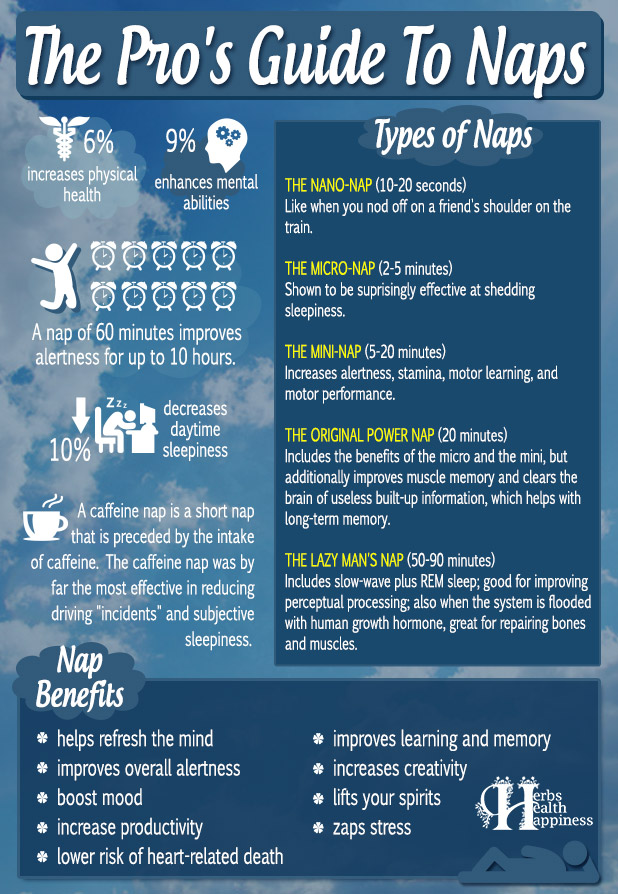
The Pros Guide To Naps. Graphic © herbshealthhappiness.com. Sky background © AdobeStock 68295797 (under license)
Napping is an activity most adults think is for the young and the old. However, napping can be extremely beneficial when conducted “properly” – whether you are a child or an adult! In general, naps can be very beneficial to your productivity and energy levels. [1] Naps can:
– Help you relax.
– Reduce your stress and fatigue.
– Make you more alert.
– Improve your mood.
– Improve your concentration.
All these benefits lead to (1) better work and/or school performance, (2) faster reaction times, and (3) improved memory. You are essentially a more productive version of yourself when you take time out of your day to rest and recharge.
The Downside Of Napping
OF course, napping isn’t for everyone. There are people who actually feel more tired after taking either a short or long nap. They are more productive when they work continually without resting. For these individuals, naps might cause sleep inertia, the feeling of disorientation after waking up from sleep. If you aren’t used to naps, this disorientation and grogginess can be carried throughout your day, messing with your performance and concentration.
If you don’t regulate your nap length properly, you might find it harder to sleep at night and it can cause insomnia. People who already find it difficult to fall asleep at night are discouraged from taking any form of naps during the day.
Take Naps If You Are:
– Extremely sleepy or fatigued. This is your body’s way of telling you to take a breather.
– About to fall asleep from too long a shift at work or long school hours.
– Finding it hard to concentrate on one (or several) tasks.
If you aren’t fatigued often but still find your need for naps increasing, seek medical help. You may have a sleeping disorder that needs to be managed by a physician.
How To Nap Like A Pro
Here are some basic guidelines in taking effective naps:
1. Keep them short. Naps should only be from 10 to 25 minutes. Any longer and you progress further into the sleep cycle, making it harder to wake up and reorganize yourself.
2. Take them in the afternoon. In some parts of the world this is called “siesta”, the time period after 12 noon and around 2 PM. Afternoon naps are the best at recharging your batteries until it’s time for bed.
3. Nap in a quiet place without distractions or disturbances. The best naps are those that are uninterrupted.
After you wake, give yourself a few minutes to recuperate before heading back to your tasks.
5 Types Of Nap And Which Is Best For A Rapid Energy Boost
1. Nano-Nap – 10 to 20 seconds of nodding off, usually enroute on public transportation or waiting for class to start.
2. Micro-Nap – two to five minutes to get rid of sleepiness.
3. Mini-Nap – five to twenty minutes to improve concentration and work performance.
4. Power Nap – 20 minutes to rest, recharge, and recover; regarded as the “ideal” length of time to nap.
5. Lazy Man’s Nap – 50 to 90 minutes to improve growth and metabolic processes, not ideal if you just want a quick pick me up at school or at work. This type of nap is best for growing children and teenagers.

Benefits Of Napping. Graphic © herbshealthhappiness.com. Background image © AdobeStock 52290408 (under license)
References:
[1] Mayo Clinic. Napping: Do’s and Don’ts for healthy adults. https://mayoclinic.org/healthy-living/adult-health/in-depth/napping/art-20048319
[2] Napping Statistics Infographic. https://thedinfographics.com/2012/07/31/napping-types-statistics-facts-and-history-infographics/
★ Get My Books - 100% FREE:
😳 Tinnitus And Brain Health?
After 47 years of studies and countless brain scans done on more than 2,400 tinnitus patients, scientists at the MIT Institute found that in a shocking 96% of cases, tinnitus was actually shrinking their brain cells.
As it turns out, tinnitus and brain health are strongly linked.
Even more interesting: The reason why top army officials are not deaf after decades of hearing machine guns, bombs going off and helicopter noises…
Is because they are using something called "the wire method", a simple protocol inspired by a classified surgery on deaf people from the 1950s...
★ How To Get Rid Of Nail Fungus:
★ Does Your Salad Contain This Vegetable?
★ 20 Natural Painkillers In Your Kitchen (Video):
★ Men's Prostate Health:

2. Famous Chef Sheds 60lbs Researching New Paleo Recipes: Get The Cookbook FREE Here
3. #1 muscle that eliminates joint and back pain, anxiety and looking fat
4. 7 odd foods that KILL your abdominal fat (surprising fat-fighters)
5. The TRUTH about bread (Will surprise you!)
6. [PROOF] Reverse Diabetes with a "Pancreas Jumpstart"
7. Here's What Happens When You "Unlock Your Hip Flexors"
8. The #1 WORST food that CAUSES Faster Aging (beware -- Are you eating this?)
The #1 Muscle That Eliminates Joint And Back Pain, Anxiety And Looking Fat
By Mike Westerdal CPT
Can you guess which muscle in your body is the #1 muscle that eliminates joint and back pain, anxiety and looking fat?
This is especially important if you spend a significant amount of time sitting every day (I do, and this really affects me in a big way!)
Working this "hidden survival muscle" that most people are simply not training because no-one ever taught them how will boost your body shape, energy levels, immune system, sexual function, strength and athletic performance when unlocked.
If this "hidden" most powerful primal muscle is healthy, we are healthy.
Is it...
a) Abs
b) Chest
c) Glutes
d) Hip Flexors
Take the quiz above and see if you got the correct answer!
P.S. Make sure you check out this page to get to know the 10 simple moves that will bring vitality back into your life:
If you enjoyed this page:












